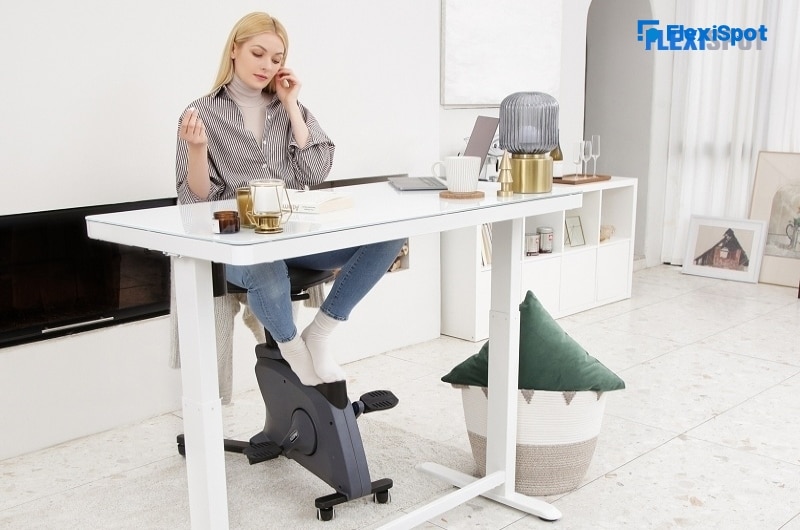Employees need to be safe and productive at work; thus, good ergonomic practices are essential. Employees who use poor ergonomic work practices or operate at poorly built workstations can contribute to the development of a variety of musculoskeletal illnesses that are avoidable.
Even workplaces that are thought to be low-risk for injuries have begun to undergo rigorous ergonomic studies in recent years. While workplace impact injuries and other catastrophic injuries are decreasing, musculoskeletal disorders (MSDs) caused by repetitive stress are increasing.
Adults in the workplace reported over 364 million lost workdays owing to musculoskeletal disorders, far more than any other chronic health issue, such as chronic high blood pressure or heart disease. Pulling, lifting, pushing, twisting, as well as prolonged sitting and bad posture, can all cause or exacerbate musculoskeletal problems.
Employers who want to reduce absenteeism due to back pain and other MSDs should start by conducting a full ergonomic assessment. Clearly, many of today's workers' sedentary lifestyles are posing major health risks and expenses to individuals and organizations across the country. But it's not all doom and gloom. Smart businesses are taking a proactive approach to address these issues.
Implementing an office ergonomics program is a part of this strategy. "The science of adapting workplace circumstances and job demands to the capabilities of the working population," according to OSHA.
If you're new to the field of office ergonomics, you might be unsure where to begin. What does the process of ergonomics improvement entail? What factors should you consider while selecting an office chair, desk, supplies, etc.?
Here, we will provide some useful tips and considerations for ergonomic assessments to help you be more productive at work. The purpose of a workplace ergonomic assessment is to assist you in identifying the issue and developing remedies and controls to lessen the danger and improve the work environment.
What is an Ergonomic Evaluation?
The study of professionals in their work surroundings is known as ergonomics. It requires changing the working conditions (physiological movements, rate of labor, and equipment) to meet the requirements of certain personnel.
An ergonomic assessment, also known as an ergonomic risk assessment, is an impartial examination of the risk factors in your workplace that may cause musculoskeletal diseases or injuries in your employees.
The assessment identifies and quantifies risk factors so that you may make measurable adjustments in the workplace. The basis for building a less injury-prone, healthier, and safer workplace, as well as increasing overall workplace wellbeing, is a thorough ergonomic examination.
HR can adopt data-backed initiatives to boost comfort and prevent injury in their workplace after performing an ergonomic assessment. Some of the conceivable office improvements include a standing desk, an adjustable chair, lumbar support, ergonomic keyboards, footrests, and much more.
Training to improve shoulder and neck posture, occupational therapy, adjustable workstations, and anti-fatigue standing mats can all help manufacturing and industrial organizations improve staff ergonomics.
Ergonomics is concerned with modifying the working environment rather than pushing workers to adapt to surroundings that may not be appropriate for their physical needs and limits. Ergonomic assessments are required for determining and addressing these needs.
7 Steps to Conducting a Workplace Ergonomic Assessment
Conducting an effective ergonomic assessment is a basic process at its core: examine the working environment, as well as how your employees interact with it. Of course, there's a lot more to it. However, as you begin your ergonomic assessment, keep these general aims in mind so that you may focus on the particulars without getting bogged down in unimportant minutiae. Here are seven step-by-step tips and considerations for ergonomic assessments:
1. Examine any previously collected data
The first stage in any ergonomics assessment is to gather information about your workplace and establish a baseline. Examine first aid logs, worker's compensation records, workplace injury reports, claims data, and any other data you have to learn about any injuries that occur at work or other incidents that have occurred at your place of business. Identify any higher-risk activities or departments, as well as common injuries and complaints, when you evaluate this data. This will enable you to focus your ergonomics evaluation and improvement efforts on the areas that will yield the best outcomes.
2. Select your Instruments
You'll gather and analyze current data on your workplace and workforce during the final three steps of your ergonomics assessment. It's crucial to take a step back and figure out how you'll measure this data before proceeding. You don't have to come up with these ergonomics measurements on your own, thankfully. Check out the Comhar all-in-one standing desk, one of the best ways to prevent injuries and muscle tension.
3. Collect subjective information
We propose starting with a hands-on, subjective examination of your current work rather than jumping right in with your chosen instruments and assessing ergonomic risk factors. Begin by taking a tour around the floor or offices to obtain a sense of the environment in which your workers operate and taking notes on any issue areas you notice.
Remember to be critical and approach your employment with fresh eyes, as if you were an outsider. Pull employees aside during your walk-through for a quick discussion regarding their working circumstances. You may boost the likelihood of early buy-in and support for any future adjustments by incorporating your staff in the process.
This stage will also provide you with vital first-hand stories and insights that you may not otherwise be able to obtain. Make sure you thoroughly describe your goals and promote open, honest feedback. Pose the following questions to your employees:
Is there any repetitive action in your job?
How frequently do you encounter pain or discomfort at work?
Do you ever get tired of doing your job?
Do you ever feel threatened in the course of your work?
Is there anything you could do at work to improve your comfort, energy, or feelings of security?
What would you do if you were in my shoes to improve the working environment?
Larger workplaces may choose to undertake an employee comfort survey in addition to face-to-face interactions with individual employees to collect more direct input.
4. Collect objective data
Use all of the information you've gathered to create a prioritized list of work activities and departments that need to be evaluated after you've studied your work injury history, walked your workplace, and gotten direct input. To measure your risk variables and finish your objective assessment, use the ergonomics assessment tools you've chosen.
5. Examine all data and assign a risk rating
Finally, compile all of the data and insights into an arranged list of risk elements and risk-reduction options. Analyze all of your current data, as well as the new objective and subjective data you collected throughout the assessment, in its entirety, as well as by task and department. Identify significant insights and risk-mitigation options, and rank them according to the likelihood of injury and severity of the injury.
We also advocate determining short- and long-term effect regions. You'll receive a detailed, actionable assessment of all ergonomic risk factors once you've finished these five steps. You're ready to devise a plan to mitigate these dangers and improve workplace ergonomics.
6. Analyze the data and rank the risks
It's time to examine what you've learned so you can discover job hazards and mitigation opportunities after you've collected both subjective and objective data and insights. Begin by going over the content in its entirety and jotting down any key points.
To get a more detailed view of risks and opportunities, look into each job type or department area. Then, in the near and long term, construct a prioritized list of task risks and mitigation possibilities to address. Throughout this procedure, ask yourself the following questions:
What is the risk of injury connected with this job?
What is the extent of the injury?
What are the chances of getting hurt?
Is it possible to mitigate or lessen the risk?
7. Create a strategy for implementing mitigation
After you've completed your analysis, it's time to put what you've learned into practice. Bring together your EHS staff, safety committee, and/or operations management, and use your list to develop a strategy for managing risks and mitigating opportunities. During your discussion, you might want to think about the following questions:
What is our timeline for implementation, and how realistic is it? (It's great if you're prepared with a proposed timeline ahead of time.)
What's the timeline for dealing with low, medium, and high-risk issues?
How will we know if we've succeeded in lowering risk?
What kind of training and resources will we need to put our ergonomics program in place, administer it, and improve it?
What other types of stakeholders should we involve?
What are some of the advantages of good ergonomics?
It is possible to avoid injuries caused by poor ergonomics. The advantages of effective ergonomic techniques include better workplace safety, higher quality, and lower corporate costs.
Enhances efficiency
Some employees are more focused on back pain, joint pain, or spinal pain rather than their work. However, with improved working conditions, the level of productivity and efficiency is significantly enhanced. Employees are pleased when their workstations are properly set up. Work efficiency can be enhanced by a flexible standing desk, such as the Comhar all-in-one standing desk, and a comfortable workstation that allows you to maintain proper posture.
Enhances the standard of living
Poor working postures can be distracting and uncomfortable for many workers. Poorly constructed workstations can lead to poor performance and staff dissatisfaction. Good ergonomic procedures ensure that workers are comfortable and productive, allowing them to produce high-quality work.
Final Thoughts
When there are no incompatibilities between the work and the worker, maximum safe work performance is possible. Ergonomic risk concerns are eliminated, and the worker's productivity is maximized. We often claim that ergonomics is excellent for business and great for people for these reasons.





